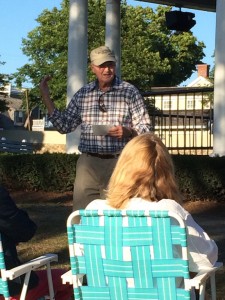On a balmy August 6 evening, a group of people sat next to the gazebo in Shipyard Park and listened to Seth Mendell as he spoke nearly extemporaneously for 45 minutes sharing the history of Captain Charles Bryant. Mendell, a well-known local historian and past president of the Mattapoisett Historical Society, gave one of his last lectures for the summer season.
Bryant’s life, as told by Mendell, is the stuff of which fiction is made. From the farm to the marbled halls of Congress, from the fields of Rochester to the turbulent oceans of the world, from south sea island maidens to the frozen vastness of the great northwest and beyond, Mendell took his audience there. But this was not, and is not, fiction. Bryant’s life was adventure, was danger, was impactful, and helped to expand the boundaries of our nation.
Bryant was born in 1820, one of seven children on a farm near Witch Rock in Rochester. As a young boy, he shouldered his fair share of farm chores, including taking produce in a horse-drawn cart down to market in Mattapoisett’s harbor.
Mendell asked the listeners to imagine those times. The smell of freshly sawn lumber would have filled the air as shipbuilders clamored from stem to stern over boats being built along the water’s edge. The sounds of hammers and voices intermingled creating a type of music and excitement by which a young boy like Bryant would be influenced.
Thus it was that Bryant at an early age “fell in love with all that was happening at the water’s edge,” as Mendell described it. With 37 working boats shipping out of Mattapoisett in the 1800s, with a working customs office, with the ebb and flow of people, Bryant would hear stories of far-away places that excited his young mind with adventures to be had. Bryant shipped out for the first time when he was 20 years old. That first trip would not only change him; it would also change the course of America’s expansion.
For the next several decades, Bryant would work on whaling ships traveling the globe. From Polynesian islands to the cold frontiers of Alaska and beyond, Bryant saw the world and experienced exotic cultures first hand. He also moved up the ranks within the sailing hierarchy, from a mere seaman to the captain his own ship.
These experiences, especially those along the Aleutian Islands and into the Bering Sea, allowed Bryant to see for himself the great natural wealth the region held. But Russia had known this for decades.
Russian hunters had long known the value of these frozen lands and had established colonies along the coast in support of a rich fur trade. Yet for Russia’s tsar, that wasn’t enough.
By the time Bryant beheld the wonders of the northern climes, Russia was struggling to sustain itself from conflicts with England. In spite of the wealth its hunters were exporting from Alaska and the surrounding territories, the tsar was eager to sell it off.
Through four U.S. administrations, the government had tried to put together deals to purchase the landmass. But lack of interest by Congress, ignorance of the vast wealth, and the potential security importance of the area impeded any deal being made.
In the meantime, Bryant had retired from whaling, returned to his much beloved port-of-call, and had settled down on his own farm in East Fairhaven with his wife, Anna, and began to enjoy a quiet domestic lifestyle. That wouldn’t last for long.
One of Bryant’s contemporaries was Senator Charles Sumner. Sumner knew of Bryant’s travels. Both Sumner and Secretary of State William Seward prevailed on Bryant to speak to Congress about the richness of the Alaskan territory. Bryant was invited to Washington to tell the senators everything he knew about Alaska. It would be many years before he would return to this area – so needed were his talents by the post-Civil War government.
Bryant’s testimony was persuasive and led to the purchase of Alaska from Russia for $7.2 million. He was named “territory administrator” and worked under the arm of the Treasury Department. His duties would require him to live in the region, forge regulations to remove Russian hunters, and mindful harvesting of seals and other animals, as well as the building of schools, hospitals and libraries as the U.S. colonized its new lands.
By 1878, Bryant was back to the gentle harbor he so loved, returning again to farming and purchasing waterfront property, and he became an innkeeper of the Bayside Tavern. That building is now known as the Inn at Shipyard Park.
Locally, Bryant remained involved in public service as a member of the school board. He could be seen walking the village streets of Mattapoisett in the winter wearing a great heavy cape he had used in Alaska – once a small boy on the farm, now a man of wealth and fame.
Several towns claim Bryant as their own: Rochester, where he was born and is buried at Sherman Cemetery; Mattapoisett, where he worked and from where he shipped; and Fairhaven, where he farmed. But, as far as Mendell is concerned, “We have the best claim on him because he loved our waterfront.”
By Marilou Newell

I am a retired professor at University of Alaska Fairbanks and eager to contact Mr. Mendell for more information about Captain Charles Bryant and his Alaskan work. We are approaching the 150 anniversary of the Purchase and focused on recognizing events surrounding the Purchase and Native response.
Thank you for your time.
Bill Schneider